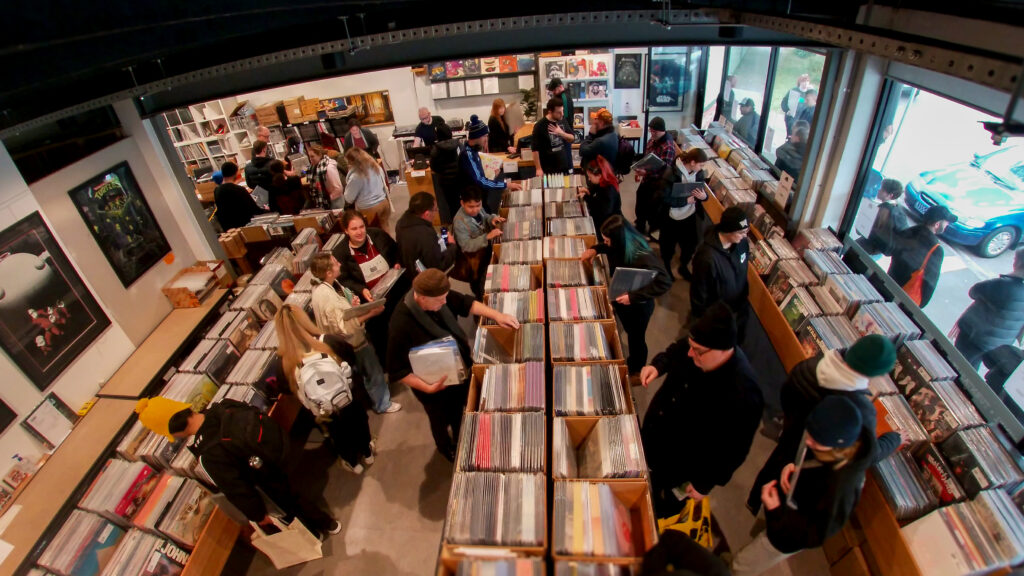“It was just a late-night jam, actually,” Sharon says. “It’s just me and Neil at home alone now that kids have gone.” Going upstairs to the music room and its old 16-track reel-to-reel tape machine (“A beautiful old thing”) for a post-dinner musical free-for-all a few years ago provided the basis of the material that makes up the band’s self-titled debut. “Neil tapes everything, and we just had a really good jam for a few nights and thought ‘This is actually quite good fun,’ so we started writing on top of those.” Initially the jams were casual, with no particular plan to do anything with them, but something about these embryonic tracks demanded to be heard. “It just started from those jams and listening back, dancing around the lounge room and thinking ‘They’re quite cool!’ We got excited. Neil took them away on tour and started a few ideas on top and brought them home. It was over the course of a year or so that they developed, in between everything else that was going on.”
Eventually Auckland musician Sean Donnelly was brought in to sprinkle some pixie dust over the tracks. “He’s a great find,” Finn says. “He’s a musician here in New Zealand under the name SJD – He’s done lots of albums himself and we’ve seen him around. We thought he would be great to bring in as a collaborator, to produce and throw around a few ideas. So Neil gave him a few things and he sent them back and we thought ‘This is cool!’ and we roped him in!” The combination of Neil’s drumming, guitar, keys and vocals, Sharon’s bass and vocals and Donnelly’s production and general sonic weirdness leaves a lot of space for experimentation. “All the wacky sonic guitary stuff was a great vehicle for Neil,” Sharon says. “He was able to do all that sort of stuff because my bass playing is so simple, it leaves plenty of room in the tracks to lay down all the other stuff.” But some of that sonic space was filled not by Neil Finn but by another famously creative chap: Johnny Marr, former sonic sculptor with the likes of The Smiths and Modest Mouse. Marr contributes guitar to two tracks, although he recorded parts for the whole album. Sharon laughs at allegations of sacrilege for daring to delete Marr’s tracks. “Haha. He just came in one day when he was here with The Cribs. He’s a good friend of ours and he sort of came in, threw his guitar on and just went to town on everything.” Some of the songs underwent considerable changes since those sessions, meaning Marr’s parts had to be jettisoned. “But he’s still on two, and great stuff too.”
The Pajama Club material includes first single Tell Me What You Want (“One of the first ones we did – a tongue-in-cheek, fun song”), From A Friend To A Friend (“Neil’s favourite”), and Golden Child a touching track about the kids leaving home. “That’s probably the most direct one lyrically,” Sharon says. “It’s really personal. Not all songs are written to personal experiences or whatever, but that one is a beautiful song. I love that song. Neil did the lion’s share of the lyric writing. There are a few things thrown in there by me. I’m just the one who sits there and goes ‘Yeah… no… yeah!'”
Although the recording features electronic touches over a pop-rock base, the live incarnation of Pajama Club is a little more tradition. “We’ve got Alana Skyring doing Neil’s drums, and she’s great,” Sharon says. “Sean does all the keys and backing vocals and I’m on the bass, singing, and Neil’s doing all the guitar stuff and a bit of keyboards. A lot of it is separate live sounds [compared to the recording] because some of it you can’t duplicate. Sean’s got a lot of the sounds that we used programmed in, but he physically plays them.”
Sharon is a relative newcomer to the bass. “I had about three bass lessons when I was about 26, with Nigel Griggs from Split Enz,” she says. “I’ve always loved the bass, but then I never did anything with it or kept playing. It’s always been my favourite instrument. And in family jams I’d get chucked on bass. Fairly remedially! But since this I’m right into it, trying to learn it properly. Because the songs were just done through jams with the bass and the drums, when you’ve got nothing to play with, it’s just you and the drums, it’s freedom. So you can play anywhere, and that’s what I did. I’d just jam out anything that takes my fancy. But I think simple is good. I’ve just always loved a groove. I don’t think you have to be particularly melodic in the bass. As long as you can lay down a really good groove, job done!”
BY PETER HODGSON







